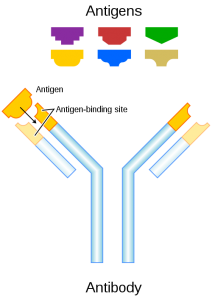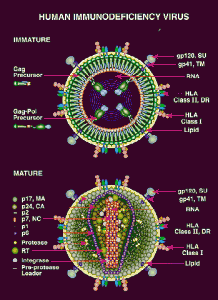
Video from University of Ontario : Media Conference on FDA Approval for SAV001
Acquired immune deficiency syndrome, better known as AIDS, was introduced to human race only a few decades ago but has since become a worldwide problem. Our society faces an AIDS pandemic. Millions of lives were taken by the disease, and more are to be lost if nothing is done to help. Vigorous researches attempt to develop a better understanding of the disease and ways to fight it. Recently, Professor Chil-Yong Kang and his colleagues at the University of West Ontario announced that they have come up with SAV001, a promising vaccine for HIV, and was approved by the FDA to proceed to human testing. Although this is enlightening news, some remain skeptical as HIV vaccines did not turn out successful in the past.
To understand why HIV vaccines are so hard to design, one must understand the mechanisms of vaccines and the nature of the HIV virus.

Image from Wikipedia by Fvasconcellos : Lock and Key Mechanism of Antibody and Antigen
Vaccines promote production of antibodies by white blood cells. Antibodies physically attach to antigens, foreign, potentially harmful molecules, or cells infected by antigens. This allows the immune system to target the tagged cells and destroy them to prevent further spread and damage. Antibodies allow such high level of specificity by recognizing epitopes which are unique and characteristic parts of antigens. In short, vaccines introduce harmless epitopes and the body produces antibodies which can be used if the real disease infects the individual later on.

Image from National Institute of Health : Mature and Immature HIV
The difficulty associated with designing an HIV vaccine is related to the fact that the epitope for this virus is very variable. There are many subtypes of HIV and a vaccine designed for specific one of them is not likely to be effective for another. The virus also has a high rate of mutation, meaning that it is possible for a virus that has been genetically modified to be harmless to mutate back to a harmful form. For such reasons previous HIV vaccine candidates either had low efficacy or actually increased the rate of infection in some of their subjects.
Dr. Kang explained that SAV001 works by infecting cells with HIV to produce more virus, collecting them, and purifying them with chemicals and radiation. The dead virus as a whole is injected to elicit antibody production and activation of associated immune responses. If all goes well, the vaccine may be commercialized within a few years.
Human testing consists of 3 phases where the vaccine is tested for its safety and efficacy. Phase I for SAV001 is to begin in January 2012. Will SAV001 turn out to be a success or leave us in another disappointment? Whatever the result may be research for AIDS prevention and cure must continue. It is not likely that SAV001 will be effective for all people and subtypes of the virus. And will it be accessible in terms of cost and availability for all the people who need it? Probably not. More work needs to be done to fully fight off the disease and the misery it brings throughout the world.
Further Reading :
http://www.vancouversun.com/health/Canadian+researchers+start+clinical+trials+vaccine+January/5887090/story.html
References :
http://communications.uwo.ca/media/hivvaccine/
http://en.wikipedia.org/wiki/Hiv_vaccine
http://www.fiercebiotech.com/topics/fda_approval_process.asp









